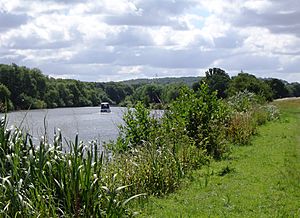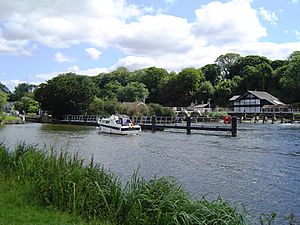Cleeve Lock facts for kids

Cleeve Lock from upstream
|
|
| Waterway | River Thames |
|---|---|
| County | Oxfordshire |
| Maintained by | Environment Agency |
| Operation | Hydraulic |
| First built | 1787 |
| Latest built | 1874 |
| Length | 40.71 m (133 ft 7 in) |
| Width | 5.53 m (18 ft 2 in) |
| Fall | 0.89 m (2 ft 11 in) |
| Above sea level | 138' |
| Distance to Teddington Lock |
66 miles |
| Power is available out of hours | |
Cleeve Lock is a special kind of gate system, called a lock, found on the River Thames in Oxfordshire, England. It helps boats move between different water levels. You can find it just upstream from a village called Streatley, right in the village of Goring. Even though it's called Cleeve Lock, there isn't actually a village named Cleeve nearby.
The very first lock here was built in 1787 by the Thames Navigation Commissioners. This lock has the smallest "fall" on the entire river. The "fall" is the difference in water level from one side of the lock to the other. Here, it's only about 0.69 meters (2 feet 3 inches). The section of the river above Cleeve Lock is the longest, and the section below it is the shortest on the non-tidal part of the Thames. A "weir" (a small dam) also runs from the river to an island just below the lock.
Contents
How to Visit Cleeve Lock
Want to see Cleeve Lock up close? You can walk to it from the village of Streatley. There's also a path that leads directly to the lock from the A329 road, which goes towards Wallingford. It's a great spot for a walk!
Cleeve Lock's Past: A Look at Its History
Long ago, in the 1500s, there was a simple type of lock called a flash lock at this spot. The first proper "pound lock" (like the one we see today) was built in 1787. It was made of strong oak wood. This lock was first going to be called Streatley Lock. But it ended up being named Cleeve Lock, after a village on the other side of the river.
For many years, until 1869, one person usually looked after both Cleeve Lock and Goring Lock. The lock was rebuilt and updated in 1874 to make it better and stronger.
Exploring the River Above Cleeve Lock
The river section above Cleeve Lock is about six and a half miles long. This makes it the longest "reach" (a straight section of river) on the Thames. Much of this area is open countryside. You'll find the small village of Moulsford and the larger town of Wallingford along this stretch.
In the past, there were two ferries here, at Little Stoke and Chalmore Hole. This was because the towpath (a path for pulling boats) switched sides of the river. You can also see Brunel's Moulsford Railway Bridge crossing the river near Moulsford. A newer road bridge, Winterbrook Bridge, crosses just downstream of Wallingford. This helps reduce traffic on the old, multi-arched Wallingford Bridge.
This part of the river is very popular for rowing. The Oxford University Boat Club and Oxford Brookes University boat club both have buildings near Wallingford. The Wallingford Rowing Club is also based here. A rowing race called the Wallingford Long Distance Sculls happens on this river section every October.
The Thames Path is a walking trail that follows the river. On this section, it stays on the western bank. Sometimes, it goes inland for a bit, like near Moulsford, before returning to the river. There's also a small detour in Wallingford. The path then stays on the western bank until Benson Lock. On the other side of the river, the Ridgeway trail runs parallel to the Thames Path as far as Winterbrook Bridge.
Cleeve Lock in Books and Stories
Cleeve Lock is even mentioned in a famous book! In Jerome K. Jerome's Three Men in a Boat, the main character talks about a long and worrying trip to Cleeve Lock. This happened because he had an old map that showed an extra lock at Wallingford that wasn't there anymore.
This story is based on real history. A lock called Chalmore Lock was built in 1838 near Wallingford. It was a "summer or low-water lock and weir." Even though it was starting to fall apart by 1873, the people of Wallingford wanted to keep it. But it was finally removed in 1883 after a bad report from Sir John Hawkshaw.




